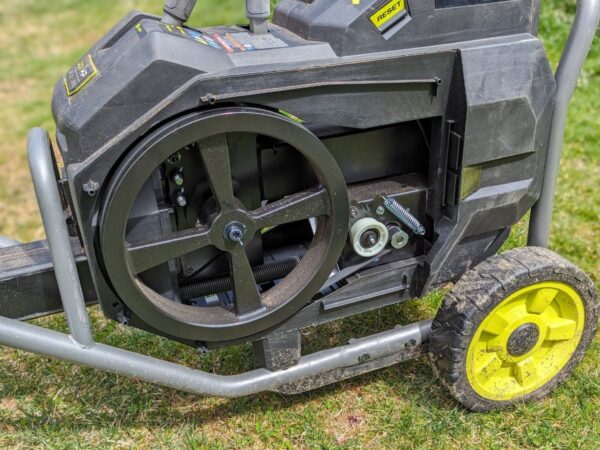Ryobi 40V HP Battery Log Splitter Review
Ryobi 40V HP Battery Kinetic Log Splitter Review

Brushless Kinetic Log Splitter

A battery-powered log splitter is not a tool that was on my radar. However, while browsing the Ryobi website I came across the Model RY40740. At first, I scoffed at the idea of a battery-powered machine being worthwhile. I am somewhat of a purist when it comes to processing firewood. Splitters in my mind need hydraulic systems powered by gas engines with rugged pump valves to be useful. The Ryobi eliminates all of that!
Ryobi Log Splitter Specifications
- Splitting Force: 12 Tons
- Cycle Time: 2 Seconds
- Maximum Log Diameter: 10″
- Maximum Log Length: 20″
- Weight: 177 Lbs.
- Warranty: 5 Year Limited
How Does it Work?
The Ryobi holds the crown of being the first battery-powered kinetic log splitter. Electric log splitters have been commercially available for decades and farmers and mad scientist mechanics have been building them in barns for even longer. However, the 40V HP splitter is the first machine to feature a dedicated battery-powered system. Furthermore, the 40V HP system utilizes Ryobi’s vastly popular 40V lithium-ion batteries as its powerplant.

Yet a robust battery system alone wouldn’t be enough to power a traditional-style log splitter. Traditional splitters rely upon hydraulic fluid to push a ram forward through a cylinder to then split a piece of wood. This is a slower process and requires a great deal of power and a very strong pump to accomplish. If you are interested in learning more about hydraulic splitters, you can read more here. Ryobi took a completely different approach.

The plastic housing was removed for the photo. It is not recommended to run the machine with the housing removed.
The 40V HP splitter features a flywheel system that utilizes kinetic energy to shoot a steel ram forward. The ram travels with such speed and velocity that it will split the piece of wood quickly and look awesome while doing it! As the ram extends, it stretches out coil springs that are attached to the bottom portion. Once the ram fully extends, these springs automatically retract it backward. A typical hydraulic log splitter will have a total cycle time of the ram system that is usually over ten seconds. In contrast, the Ryobi has a two-second cycle time! The kinetic system was the perfect platform that is energy efficient enough to be battery-powered.

The flywheel assembly and ram sit on top of a steel box beam. The ram runs across the top of the beam on roller guides. At the end of the beam is a vertical wedge which is stationary. There are two side rails on the side of the beam that extend down to form handles for transporting the machine. These rails also act as a cradle for the log to sit on.

Kinetic log splitters are not a new concept. They have long been praised for having fast cycle times, being lighter and more portable, and also being durable and reliable. The Ryobi 40V HP builds on that lineage with the added convenience of battery power.
Ryobi RY40740 Splitter Controls

The Ryobi features simple controls that are easy to operate. An oversized power button is located on the top of the machine’s housing. Due to the speed of the machine and the fast cycle time, it is imperative to keep your hands off of the wood that is going to be split. A two-second cycle time does not allow much room for error. To keep all ten fingers attached to your hands, Ryobi included a safety bypass lever in addition to the splitter control lever. The operator must have a hand on each of these control levers to actuate the splitter as an extra level of safety. The operator must also position themselves at the rear of the machine to properly operate the controls. This is a well-thought-out system to enhance user safety.

Occasionally, kinetic log splitters like the Ryobi will stall out. A very dense or knotty piece of wood may cause the ram to bounce off the face of the wood. When this happens, the ram knocks itself out of sync to preserve the drive assembly. To reset it, two reset buttons must be pushed simultaneously on the top of the machine. This gets everything lined up and ready to work again.
Splitting Capability

Ryobi rates the 40V HP splitter for wood with a maximum width of 10″ and a maximum length of 20″. The 10″ diameter rating is ideally suited for smaller trees and logs to make fireplace or firepit-sized pieces. I found the Ryobi splitter to excel when working with pieces this size. However, I also wanted to push the splitter to its limits. I often receive deliveries of “tree service” wood from arborist friends of mine. These loads often contain oversized pieces from takedown work. During the Ryobi testing period, I was working on a large 28″ diameter ash log. I would not expect the Ryobi to split a piece this large, but I quartered the round into more manageable-sized pieces.

The Ryobi is fully capable of splitting pieces larger than 10″. However, it often needs more than one hit from the ram. Think of it like a boxer setting up a punch combo. The first hit cracks and stuns the opponent and the follow-up hits finish it off. I used the Ryobi in a variety of wood species including maple, oak, and hickory. The machine maintained its fast cycle times and power regardless of the species. I would strongly recommend “reading” your pieces of wood while splitting. Examine the grain structure and look for knots. By rotating the piece or working around the knots, the splitter is less likely to stall and the operator will be able to split more efficiently with fewer interruptions.
Ryobi Battery-Powered Log Splitter Run-time

The Ryobi splitter is available as a kit with a single 4.0 Ah battery and charger. During testing I used the 4.0 Ah battery as well as a new 6.0 Ah battery that Ryobi sent. With a fully charged 6.0 Ah battery, I was able to complete a total of 46 minutes of continuous splitting. I staged a large pile of rounds for this and constantly fed the machine with minimal downtime. I was completely blown away by the performance of the machine on a single battery charge! What is even more impressive is the amount of wood I was able to split during that time frame. With a two-second cycle time, I had to hustle to keep the Ryobi fed. Overall I filled the bed of my Polaris Ranger to the point that it was overflowing during this test.

The 4.0 Ah battery was able to split an overflowing 10-yard wheelbarrow load of wood on a single charge. Based upon this, the 4.0 Ah battery would be more than enough power to keep a fire pit fed for a weekend or periodically split in the evening to prepare for the fall/winter burning seasons. I used a Ryobi 40V Dual Port Rapid Charger with both batteries. This charger allowed one battery to completely recharge in the time it took me to deplete the other. This combo of batteries with a rapid charger would allow for a full day of splitting with minimal downtime.

Mobility and Portability

The compact design of the Ryobi makes it easy to transport. The front legs act as handles and there are solid plastic wheels on the rear of the machine. This allows the splitter to be moved like a wheelbarrow. The machine can also be stood up for storage. The 40V HP Splitter weighs a total of 177 Lbs. Two people can easily load the splitter into a pickup truck bed for transport. There is no towing option for the splitter currently.
Unfortunately, the high center of gravity on the splitter makes it prone to tipping over while moving. The small plastic wheels are unstable in off road conditions and the splitter fell over more than once while I was transporting it to my different splitting areas.

Another downfall of such a compact design is the work height. The beam of the splitter is less than a foot off the ground, which is convenient for lifting heavy pieces of wood, but forces the operator to crouch down or work on one knee. Using the machine for extended periods of time may result in back and leg fatigue. To alleviate this, I would suggest positioning the splitter on a raised platform or possibly a cart. I plan to mill a large log in half to act as a pedestal for the splitter to sit on and my back is already thanking me.
Overall Impressions

A battery-powered log splitter is not a tool that I saw coming, but I am very glad that it is here. The Ryobi 40V HP kinetic log splitter is an outstanding option for homeowners and hobbyists who are looking for a portable and easy-to-use machine without the hassle of gas-powered engine maintenance and bulky hydraulic systems. More importantly, it is fun to use! As the ram shoots forward to split a piece of wood it makes an incredible POW! and then immediately retracts, just as fast as it started. Like a professional boxer or mixed martial artist throwing jabs and punches.

The compact size makes it easy to store and move around and did I mention less maintenance? The only maintenance I would suggest is keeping the box beam clear of built-up debris and also spraying lubricant on the ram rollers. Less resistance on these parts will enhance the lifespan.

The Ryobi is well-suited for homeowners who need to split smaller quantities of firewood for fire pits, fireplaces, small wood stoves, or for cooking. It makes a great travel companion too for remote campsites or cabins to help process campfire wood. Additionally, I would strongly suggest the Ryobi 40V HP splitter to anyone who receives wood deliveries for heating that need to be re-split. Firewood pieces produced by commercial splitters are often too large for small fireplaces or stoves. Homeowners will often need to re-split these pieces down to size with a maul or other tools. The Ryobi can be operated inside a garage or basement to do these re-splits with no hazardous fumes or excessive engine noise.
Price and Availability
The Ryobi battery-powered log splitter is currently available exclusively from the Home Depot. The kit option includes the splitter with charger and one 4.0 Ah battery for $999.00. A bare tool option will be available soon for $899.00. Overall I think is a good value on a very versatile machine. The Ryobi is faster and more rugged than any other commercially available electric homeowner machine I have seen. The kinetic system offers power and performance above almost anything else on the market. Combine this with the 40V HP battery system and it is a great option for a variety of users. I recommend this option to anyone who doesn’t want to deal with a gas splitter. It is also faster and more potentially productive than any hydraulic splitter in the same price range.
The Buy Now link below is available to order the Ryobi RY40740 directly from Home Depot!
#HomeDepotPartner
#MyHomeDepot
About the author
Disclosure
Product reviews on this site contain our opinion of a product or service. We will always strive for objectivity and transparency in our reviews. Our goal is to provide readers with honest, objective information based on our own experiences. We never have and never will accept payment in exchange for a positive review. Many of the products that we review are provided to us for free by a manufacturer or retailer. In some cases, we also have advertising or affiliate relationships with manufacturers and retailers of products and services we review. For additional information please visit our additional disclosure policies.























